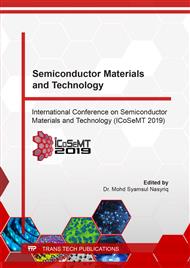[1]
C. Battaglia, A. Cuevas, and S. De Wolf, High-efficiency crystalline silicon solar cells: Status and perspectives,, Energy Environ. Sci., vol. 9, no. 5, p.1552–1576, (2016).
DOI: 10.1039/c5ee03380b
Google Scholar
[2]
Y. F. Zhuang, S. H. Zhong, Z. G. Huang, and W. Z. Shen, Versatile strategies for improving the performance of diamond wire sawn mc-Si solar cells,, Sol. Energy Mater. Sol. Cells, vol. 153, p.18–24, (2016).
DOI: 10.1016/j.solmat.2016.04.014
Google Scholar
[3]
E. Vazsonyi, K. De Clercq, R. Einhaus, E. Van Kerschaver, K. Said, J. Poortmans, J. Szlufcik, and J. Nijs, Improved anisotropic etching process for industrial texturing of silicon solar cells,, Sol. Energy Mater. Sol. Cells, vol. 57, no. 2, p.179–188, (1999).
DOI: 10.1016/s0927-0248(98)00180-9
Google Scholar
[4]
Y. Wang, L. Yang, Y. Liu, Z. Mei, W. Chen, J. Li, H. Liang, A. Kuznetsov, and D. Xiaolong, Maskless inverted pyramid texturization of silicon,, Sci. Rep., vol. 5, no. 0316, p.1–7, (2015).
DOI: 10.1038/srep10843
Google Scholar
[5]
Z. Zhao, P. Li, Y. Wei, C. Lu, X. Tan, and A. Liu, 17.3% Efficient Black Silicon Solar Cell Without Dielectric Antireflection Coating,, Sol. Energy, vol. 110, p.714–719, (2014).
DOI: 10.1016/j.solener.2014.10.029
Google Scholar
[6]
M. Otto, M. Algasinger, H. Branz, B. Gesemann, T. Gimpel, K. Füchsel, T. Käsebier, S. Kontermann, S. Koynov, X. Li, V. Naumann, J. Oh, A. N. Sprafke, J. Ziegler, M. Zilk, and R. B. Wehrspohn, Black silicon photovoltaics,, Adv. Opt. Mater., vol. 3, no. 2, p.147–164, (2015).
DOI: 10.1364/pv.2014.ptu2c.2
Google Scholar
[7]
W. K. To, C. H. Tsang, H. H. Li, and Z. Huang, Fabrication of n-type mesoporous silicon nanowires by one-step etching,, Nano Lett., vol. 11, no. 12, p.5252–5258, (2011).
DOI: 10.1021/nl202674t
Google Scholar
[8]
F. Es, M. Kulakci, and R. Turan, An Alternative Metal-Assisted Etching Route for Texturing Silicon Wafers for Solar Cell Applications,, IEEE J. Photovoltaics, vol. 6, no. 2, p.440–446, (2016).
DOI: 10.1109/jphotov.2016.2520207
Google Scholar
[9]
Z. Huang, N. Geyer, P. Werner, J. De Boor, and U. Gösele, Metal-assisted chemical etching of silicon: A review,, Adv. Mater., vol. 23, no. 2, p.285–308, (2011).
DOI: 10.1002/adma.201001784
Google Scholar
[10]
J. Oh, H. C. Yuan, and H. M. Branz, An 18.2%-efficient black-silicon solar cell achieved through control of carrier recombination in nanostructures,, Nat. Nanotechnol., vol. 7, no. 11, p.743–748, (2012).
DOI: 10.1038/nnano.2012.166
Google Scholar
[11]
M. Z. Pakhuruddin, J. Huang, J. Dore, and S. Varlamov, Enhanced light-trapping in laser-crystallised silicon thin-film solar cells on glass by optimised back surface reflectors,, Sol. Energy, vol. 150, p.477–484, (2017).
DOI: 10.1016/j.solener.2017.04.069
Google Scholar
[12]
N. A. M. Noor, S. K. Mohamad, S. S. Hamil, M. Devarajan, and M. Z. Pakhuruddin, Effects of etching time towards broadband absorption enhancement in black silicon fabricated by silver-assisted chemical etching,, Optik (Stuttg)., vol. 176, no. November 2018, p.586–592, (2019).
DOI: 10.1016/j.ijleo.2018.09.096
Google Scholar
[13]
S. K. Srivastava, D. Kumar, Vandana, M. Sharma, R. Kumar, and P. K. Singh, Silver catalyzed nano-texturing of silicon surfaces for solar cell applications,, Sol. Energy Mater. Sol. Cells, vol. 100, p.33–38, (2012).
DOI: 10.1016/j.solmat.2011.05.003
Google Scholar
[14]
C. Chartier, S. Bastide, and C. Lévy-Clément, Metal-assisted chemical etching of silicon in HF-H2O2,, Electrochim. Acta, vol. 53, no. 17, p.5509–5516, (2008).
DOI: 10.1016/j.electacta.2008.03.009
Google Scholar
[15]
W. Kern, The Evolution of Silicon Wafer Cleaning Technology,, J. Electrochem. Soc., vol. 137, no. 6, p.1887, (1990).
Google Scholar
[16]
N. A. M. Noor, S. K. Mohamad, S. S. Hamil and M. Z. Pakhuruddin, Effects of annealing temperature towards surface morphological and optical properties of black silicon fabricated by silver-assisted chemical etching,, Mater. Sci. Semicond. Process., vol. 91, p.167–173, (2019).
DOI: 10.1016/j.mssp.2018.11.006
Google Scholar
[17]
M. Z. Pakhuruddin, J. Huang, J. Dore, and S. Varlamov, Enhanced Absorption in Laser-Crystallized Silicon Thin Films on Textured Glass,, IEEE J. Photovoltaics, vol. 6, no. 4, p.852–859, (2016).
DOI: 10.1109/jphotov.2016.2545410
Google Scholar
[18]
M. Abouda Lachiheb, N. Nafie, and M. Bouaicha, The dual role of silver during silicon etching in HF solution,, Nanoscale Res. Lett., vol. 7, p.3–7, (2012).
DOI: 10.1186/1556-276x-7-455
Google Scholar
[19]
K. Peng, A. Lu, R. Zhang, and S. T. Lee, Motility of metal nanoparticles in silicon and induced anisotropic silicon etching,, Adv. Funct. Mater., vol. 18, no. 19, p.3026–3035, (2008).
DOI: 10.1002/adfm.200800371
Google Scholar
[20]
Z. R. Smith, R. L. Smith, and S. D. Collins, Electrochimica Acta Mechanism of nanowire formation in metal assisted chemical etching,, vol. 92, p.139–147, (2013).
DOI: 10.1016/j.electacta.2012.12.075
Google Scholar
[21]
C. H. Hsu, J. R. Wu, Y. T. Lu, D. J. Flood, A. R. Barron, and L. C. Chen, Fabrication and characteristics of black silicon for solar cell applications: An overview,, Mater. Sci. Semicond. Process., vol. 25, p.2–17, (2014).
DOI: 10.1016/j.mssp.2014.02.005
Google Scholar
[22]
X. He, S. Li, W. Ma, Z. Ding, J. Yu, B. Qin, J. Yang, Y. X. Zou, and J. Qiu, A simple and low-cost chemical etching method for controllable fabrication of large-scale kinked silicon nanowires,, Mater. Lett., vol. 196, p.269–272, (2017).
DOI: 10.1016/j.matlet.2017.03.131
Google Scholar
[23]
S. Li, W. Ma, X. Chen, K. Xie, Y. Li, X. He, X. Yang, and Y. Lei, Structure and antireflection properties of SiNWs arrays form mc-Si wafer through Ag-catalyzed chemical etching,, Appl. Surf. Sci., vol. 369, p.232–240, (2016).
DOI: 10.1016/j.apsusc.2016.02.028
Google Scholar


